Table of Contents
- Introduction
- Editor’s Choice
- Robot Statistics – Global Overview
- Robot Statistics by Type
- Military and Defense Robots – Robot Statistics
- Robot Statistics by Application
- Robot Statistics – Healthcare and Medical Fields
- Robot Workforce and Employment Impact
- Robot Safety and Ethical Considerations
- Future Prospects of Robotics
- Recent Developments
- Wrap Up
- FAQs
Introduction
Robot Statistics: The field of robotics has undergone remarkable advancements in recent years. Revolutionizing industries, shaping economies, and transforming the way we live and work.
Robots, once confined to the realms of science fiction, have become a tangible reality in our modern world.
These machines, capable of carrying out tasks autonomously or semi-autonomously, have found applications in diverse sectors. From manufacturing and healthcare to agriculture, transportation, and beyond.
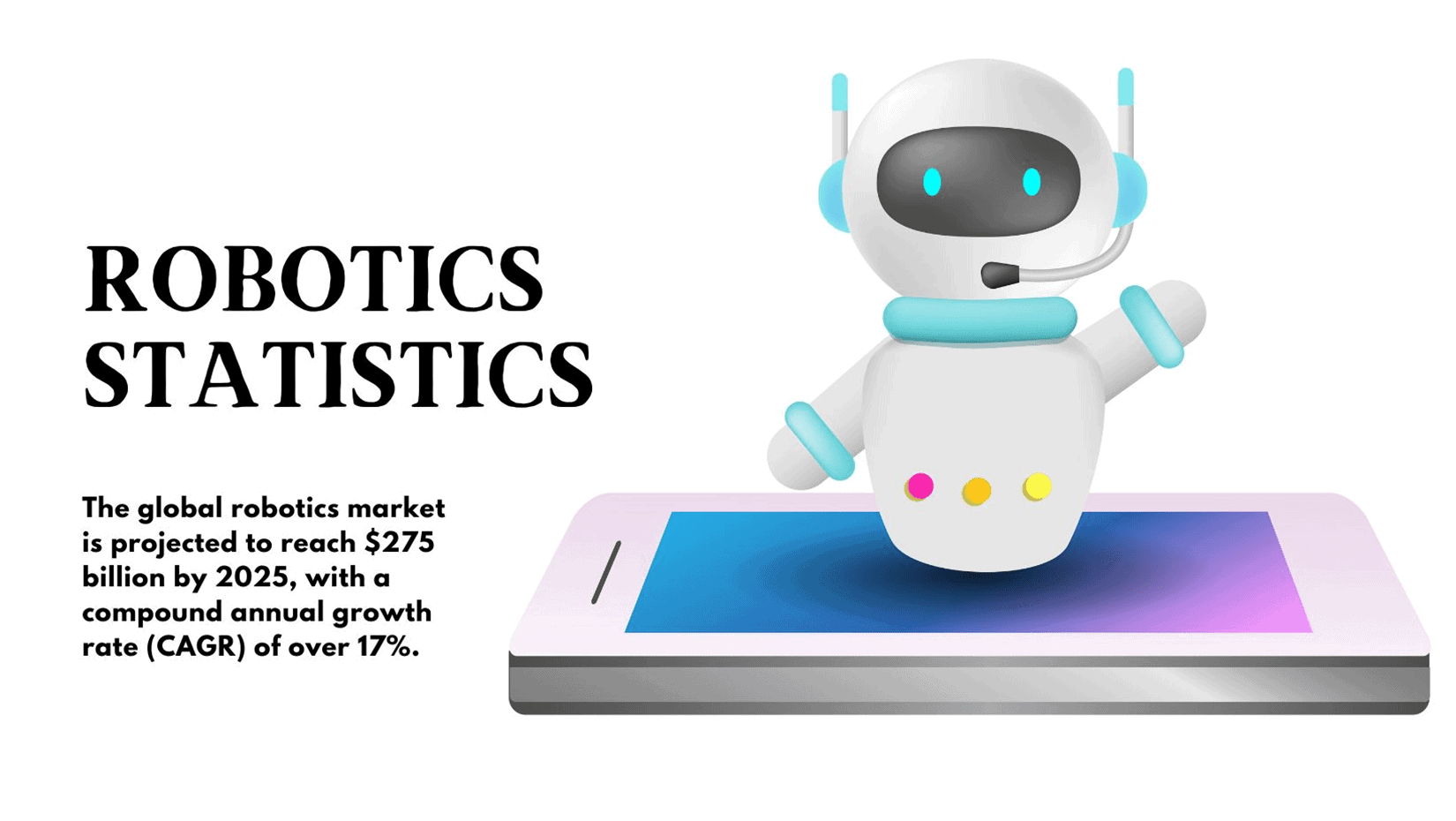
Editor’s Choice
- The Global Robot Software Market size is expected to be worth around USD 120.5 Billion by 2033. From USD 16.5 Billion in 2023, growing at a CAGR of 22.0% during the forecast period from 2024 to 2033.
- In 2022, the global sales of industrial robots reached a record high of 384,000 units, indicating significant adoption in manufacturing.
- The service robotics market is projected to surpass $20 billion by 2023. Domestic and healthcare robots are major growth drivers.
- China has emerged as the largest market for industrial robots, accounting for approximately 38% of global robot sales in 2021.
- By 2025, the autonomous vehicles market is estimated to be worth over $500 billion, driven by advancements in self-driving technology.
- The adoption of collaborative robots (cobots) is rising rapidly. With an expected annual growth rate of 40% in the coming years.
- The global market for military robots is anticipated to exceed $30 billion by 2025, fueled by increasing defense investments worldwide.
- Job displacement due to automation is a growing concern. With estimates suggesting that robots could replace up to 20 million manufacturing jobs by 2030.
(Source: International Federation of Robotics – IFR, Statista, Boston Consulting Group, BIS Research, Oxford Economics)
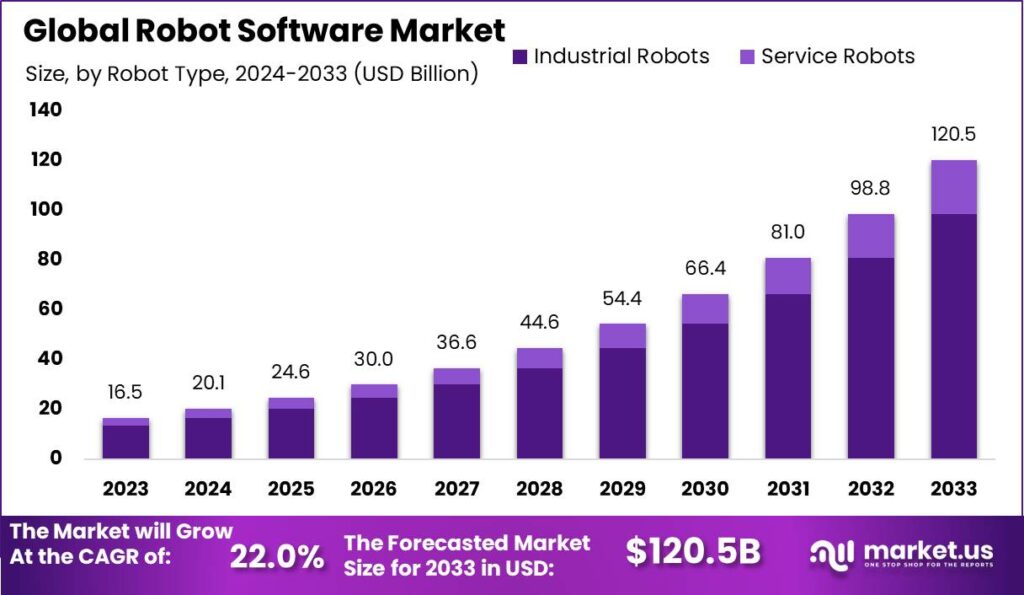
Robot Statistics – Global Overview
- In 2022, the Global Industrial Robotics Market was valued at USD 48.5 billion. Between 2023 and 2032, this market is estimated to register the highest CAGR of 11.4%. It is expected to reach USD 142.8 billion in the forecast period.
- In 2022, the Global Warehouse Robotics Market was valued at USD 5.5 billion and is expected to grow around USD 19.2 billion by 2032. This market is estimated to register at a CAGR of 13.3% during the forecast period of 2023 to 2032.
- The Global Surgical Robotics Market size is expected to be worth around USD 25.7 Billion by 2032 from USD 6.2 Billion in 2022. Growing at a CAGR of 15.70% during the forecast period from 2023 to 2032.
- In 2020, approximately 2.7 million industrial robots were operating worldwide, with the automotive and electronics sectors being the largest adopters.
- Robot density, is measured by the number of industrial robots per 10,000 employees. This is highest in South Korea, followed by Singapore, Germany, and Japan.
(Source: International Federation of Robotics)

Robot Statistics by Type
Industrial Robots
- Global industrial robot sales reached 384,000 units in 2020, a 3.5% increase from the previous year.
- China remained the largest market for industrial robots, accounting for 37% of total sales in 2020.
- The automotive industry remains the largest adopter of industrial robots, with a 28% share of total robot installations.
- The electrical/electronics industry ranks second in robot adoption, with a 22% share of global installations.
- Collaborative robots (cobots) are gaining popularity, and their sales increased by 11% in 2020, reaching 52,000 units globally.
- The average global robot density in the manufacturing industry is 113 robots per 10,000 employees.
- Japan has the highest robot density globally, with 1,562 robots per 10,000 employees in its manufacturing industry.
- By 2025, the International Federation of Robotics projects the global stock of industrial robots to exceed 3 million units.
(Source: IFR)
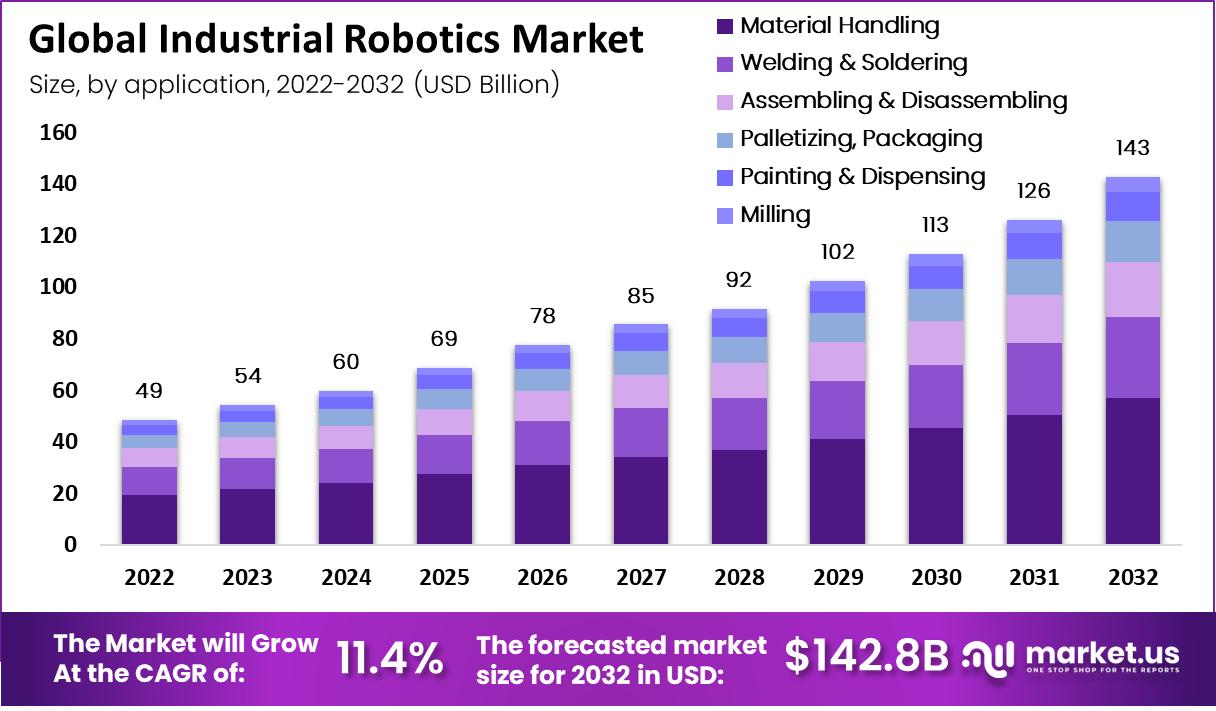
Robot Statistics – Domestic and Personal Service Robots
- The domestic and personal service robot market is projected to reach $14.7 billion by 2025.
- In 2021, the sales of domestic robots, such as robotic vacuum cleaners, exceeded 20 million units globally.
- Personal service robots, including companion and assistive robots, are expected to experience a compound annual growth rate (CAGR) of over 30% from 2021 to 2026.
- Robotic vacuum cleaners account for nearly 70% of all domestic robot sales, with increasing demand for smart, autonomous cleaning solutions.
- The Asia-Pacific region leads the adoption of domestic and personal service robots. Accounting for around 40% of the global market share.
- As of 2021, approximately 17% of households in the United States owned at least one domestic robot, reflecting a growing trend in robot adoption.
(Source: Business Wire, International Federation of Robotics, Statista, The Verge)
Take advantage of our unbeatable offer - buy now!

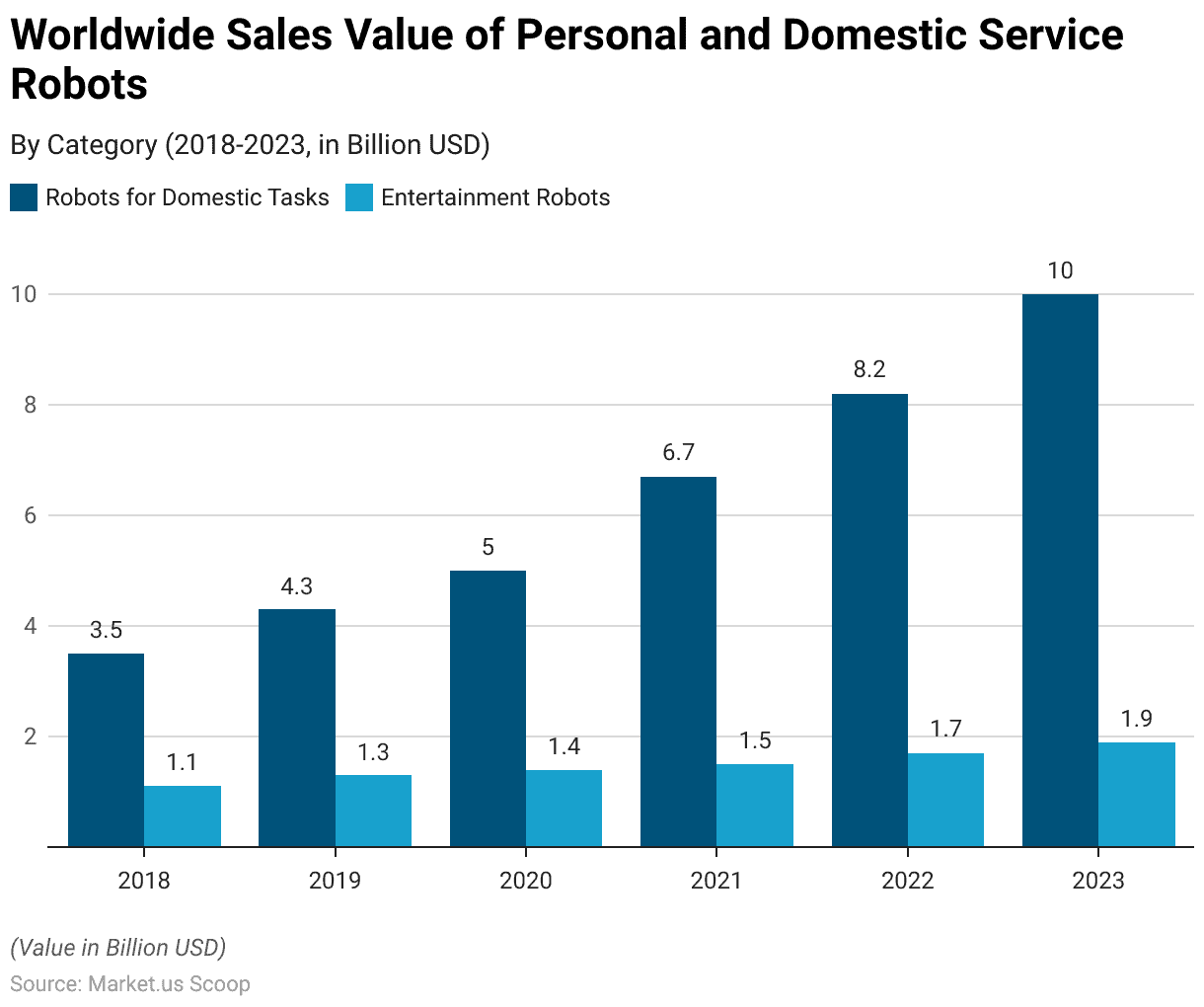
Service Robots – Robot Statistics
- The global service robot market is projected to reach $24.64 billion by 2026. With a CAGR of 21.4% from 2021 to 2026.
- In 2020, the sales of domestic service robots, such as vacuum cleaners and lawnmowers, reached 5.44 million units worldwide.
- Healthcare service robots are expected to have a CAGR of 17.3% from 2021 to 2028. Driven by the demand for automation in healthcare facilities.
- The adoption of service robots in the hospitality industry is projected to grow at a CAGR of 18.2% from 2021 to 2026, enhancing guest experiences.
- Personal and domestic service robots are gaining popularity, and the market is expected to grow at a CAGR of 16.9% from 2021 to 2028.
- By 2024, the global market for professional cleaning service robots is expected to reach $5.5 billion, driven by the need for efficient cleaning solutions.
- The global market for medical robots is projected to reach $20.70 billion by 2023. With a significant role in surgery and rehabilitation.
- The education and research robot market is anticipated to grow at a CAGR of 17.2% from 2021 to 2028, supporting learning and experimentation.
(Source: International Federation of Robotics – World Robotics, Business Wire)
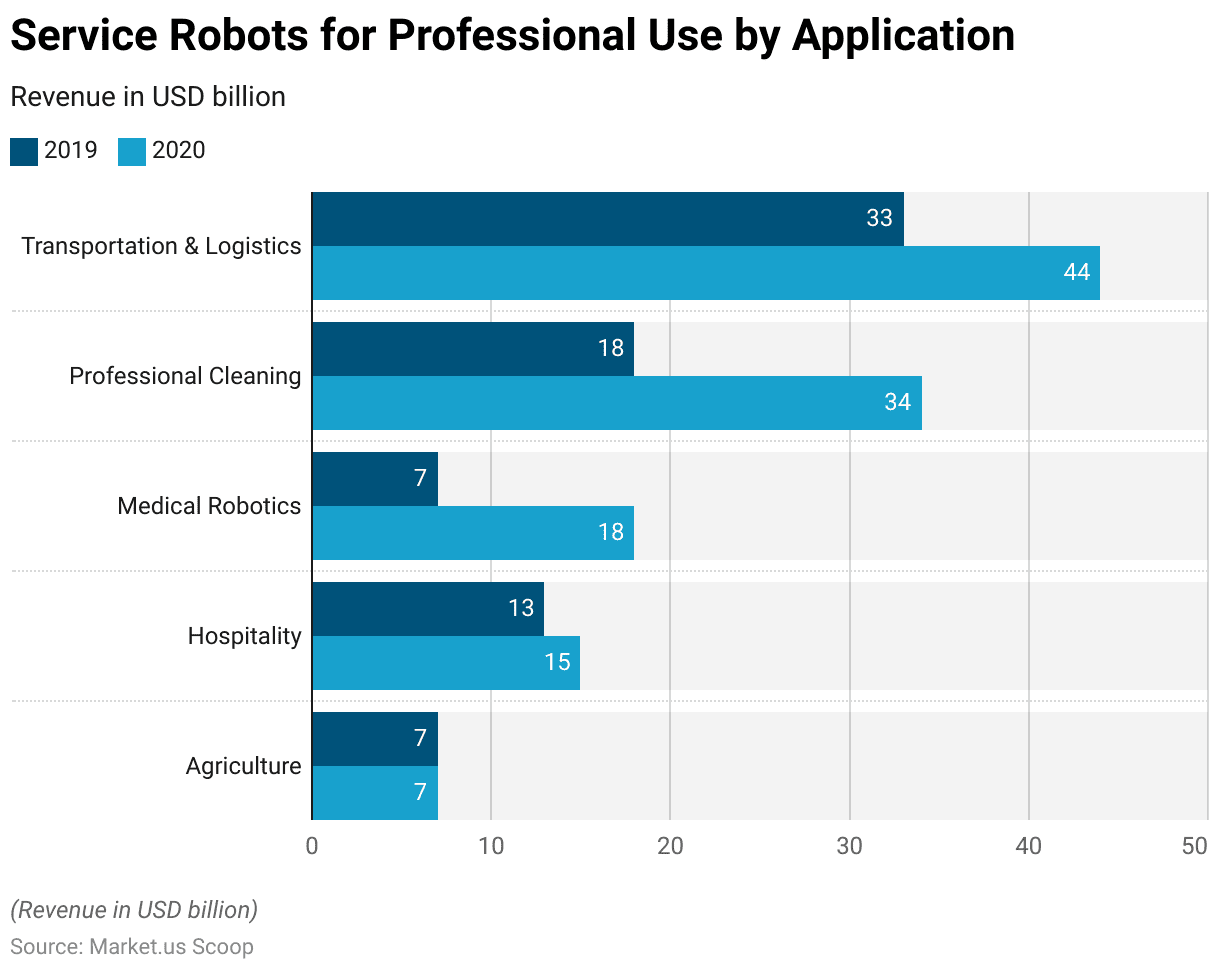
Healthcare and Medical Robots – Robot Statistics
- The global medical robotics market is projected to reach $20 billion by 2023. With a compound annual growth rate (CAGR) of over 20%.
- Surgical robots are expected to dominate the medical robotics market, accounting for approximately 70% of total revenue.
- By 2024, it is estimated that there will be more than 10,000 robots in healthcare worldwide. Assisting in various medical procedures.
- Robot-assisted surgeries have shown a reduction in patient hospital stays by 21% and a decrease in overall post-operative complications by 25%.
- In the United States, the adoption of robotic surgical systems increased by 26% between 2012 and 2018, with over 3,800 systems in operation.
- Telemedicine robots are becoming increasingly popular. With a growth rate of 41.2% from 2020 to 2027, offering remote healthcare services in underserved areas.
- Robot-assisted rehabilitation therapies have demonstrated a significant improvement in motor function recovery among stroke patients. With up to 34% better outcomes compared to conventional therapies.
- The demand for service robots in healthcare settings, including delivery robots in hospitals, is expected to surge by 40% annually. Driven by the need for contactless delivery during the COVID-19 pandemic.
(Source: IFR World Robotics, Intuitive Surgical, Journal of Healthcare Robotics, Journal of NeuroEngineering and Rehabilitation, Robotics Tomorrow)
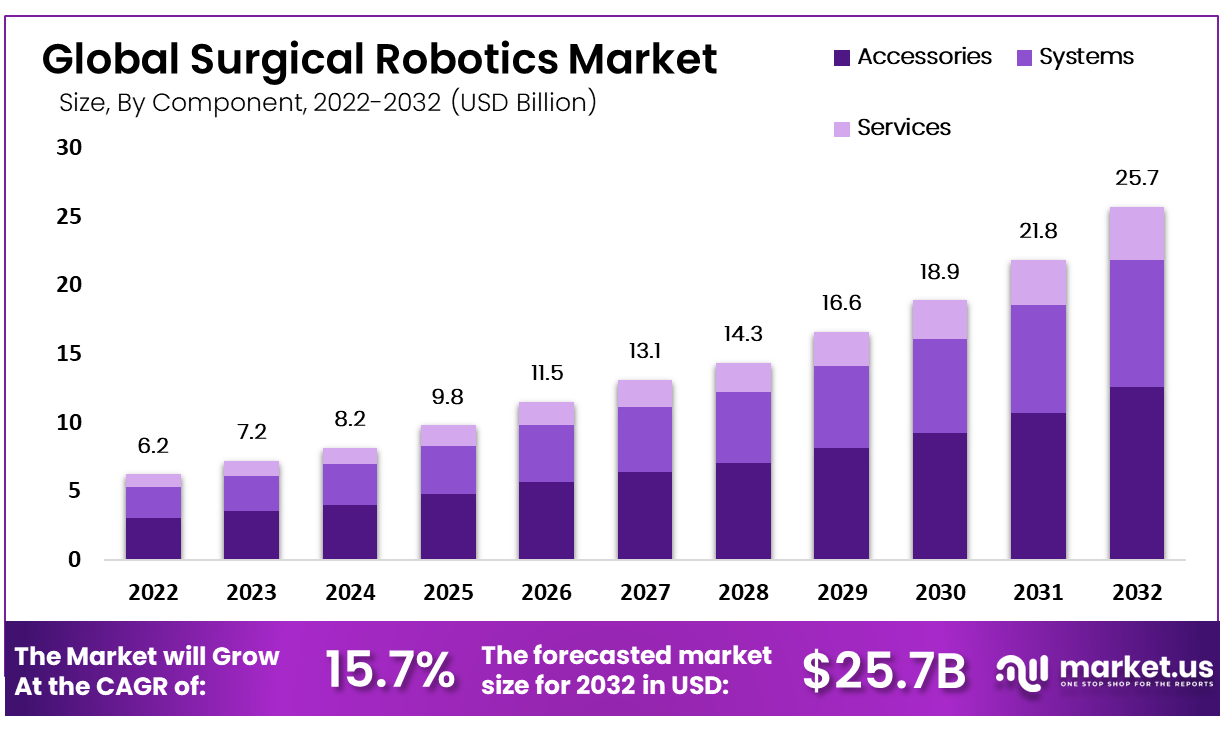
Military and Defense Robots – Robot Statistics
- The global military robotics market is projected to reach $30.37 billion by 2027, with a CAGR of 9.8% from 2020 to 2027.
- Unmanned Aerial Vehicles (UAVs) accounted for approximately 78% of the total military robotics market share in 2020.
- The U.S. Department of Defense has increased its spending on robotics and autonomous systems, with an investment of $1.5 billion in fiscal year 2021.
- The adoption of ground-based military robots is growing rapidly, with a forecasted market size of $11.83 billion by 2027.
- Explosive Ordnance Disposal (EOD) robots have saved countless lives. As they are responsible for 90% of the bomb disposals conducted by the U.S. military.
- China is also actively investing in military robotics, with its ground robot sales expected to reach $225 million by 2023.
- In 2020, the Israeli defense company Elbit Systems sold $70 million worth of unmanned ground vehicles to a Southeast Asian country.
- Autonomous marine vehicles, used for tasks such as surveillance and mine countermeasures, are anticipated to grow at a CAGR of 10.4% from 2021 to 2028.
(Source: Business Wire, The National Defense Authorization Act for Fiscal Year 2021, NBC News, South China Morning Post, Reuters)
Entertainment and Educational Robots
- The global entertainment robot market is projected to reach $22.4 billion by 2023, growing at a CAGR of 11.2%.
- Educational robot sales reached 170,000 units in 2020, with a 29% year-on-year increase, indicating rising popularity in schools and learning environments.
- The most common type of entertainment robot is the toy robot, accounting for approximately 75% of all entertainment robot sales worldwide.
- STEM (Science, Technology, Engineering, and Mathematics) educational robots have experienced significant growth, with a 40% increase in sales in the last three years.
- Asia-Pacific is the largest market for both entertainment and educational robots, accounting for over 45% of global sales.
(Source: International Federation of Robotics, Statista, PR Newswire, Robotics Business Review)
Robot Statistics by Application
Robotics in Manufacturing and Automation
- Global industrial robot sales reached a record high of 422,271 units in 2020, indicating the increasing adoption of robotics in manufacturing.
- China remains the largest market for industrial robots, accounting for 39% of the total global sales in 2020.
- The automotive industry is the biggest customer of industrial robots, comprising 30% of the total robot installations in 2020.
- Collaborative robots, or cobots, are gaining popularity in manufacturing, with an estimated annual growth rate of 17.4% from 2021 to 2028.
- The global market for industrial automation is projected to reach USD 326.14 billion by 2027, driven by the demand for increased productivity and efficiency.
- Over 2.4 million industrial robots are expected to be installed in factories worldwide by 2025, signaling a significant rise in automation.
- The food and beverage industry is experiencing substantial robot adoption, with a CAGR of 15.2% predicted for the period 2021-2028.
- The United States is the second-largest market for industrial robots, accounting for 17% of global sales in 2020.
(Source: International Federation of Robotics, Statista)
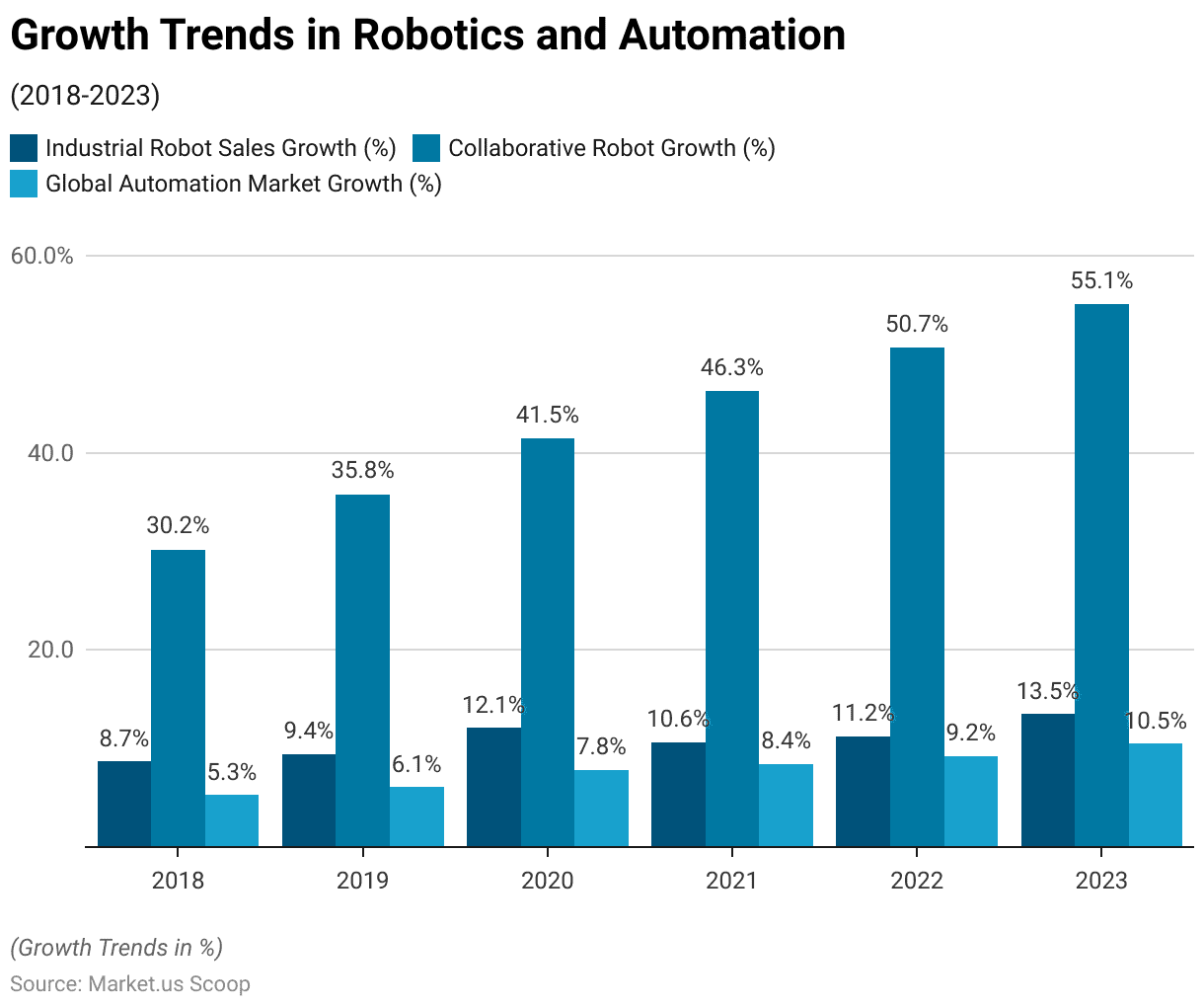
Robot Statistics – Healthcare and Medical Fields
- The global medical robotics market is projected to reach $20.6 billion by 2026, growing at a CAGR of 21.1% from 2021 to 2026.
- Surgical robots are expected to dominate the medical robotics market, with a share of 79.3% in 2020.
- In 2021, the adoption of telemedicine robots increased by 50%, enabling remote consultations and patient monitoring.
- The use of robot-assisted surgery reduced the length of hospital stays by 21% and decreased post-operative complications by 26% compared to traditional surgery.
- Rehabilitation robots are witnessing rapid growth, and the global market is projected to surpass $2.1 billion by 2026.
- The implementation of robotic automation in pharmacies has increased medication dispensing accuracy to 99.9%, reducing medication errors and improving patient safety.
- Exoskeleton robots for rehabilitation purposes are estimated to reach a market value of $2.4 billion by 2026, driven by their potential to aid patients with mobility impairments.
- Medical robots equipped with AI algorithms have demonstrated diagnostic accuracy rates of over 90% in various medical imaging tasks, including detecting tumors and abnormalities.
(Source: Frost & Sullivan, NCBI, Pharmacy Times, Journal of the National Cancer Institute)
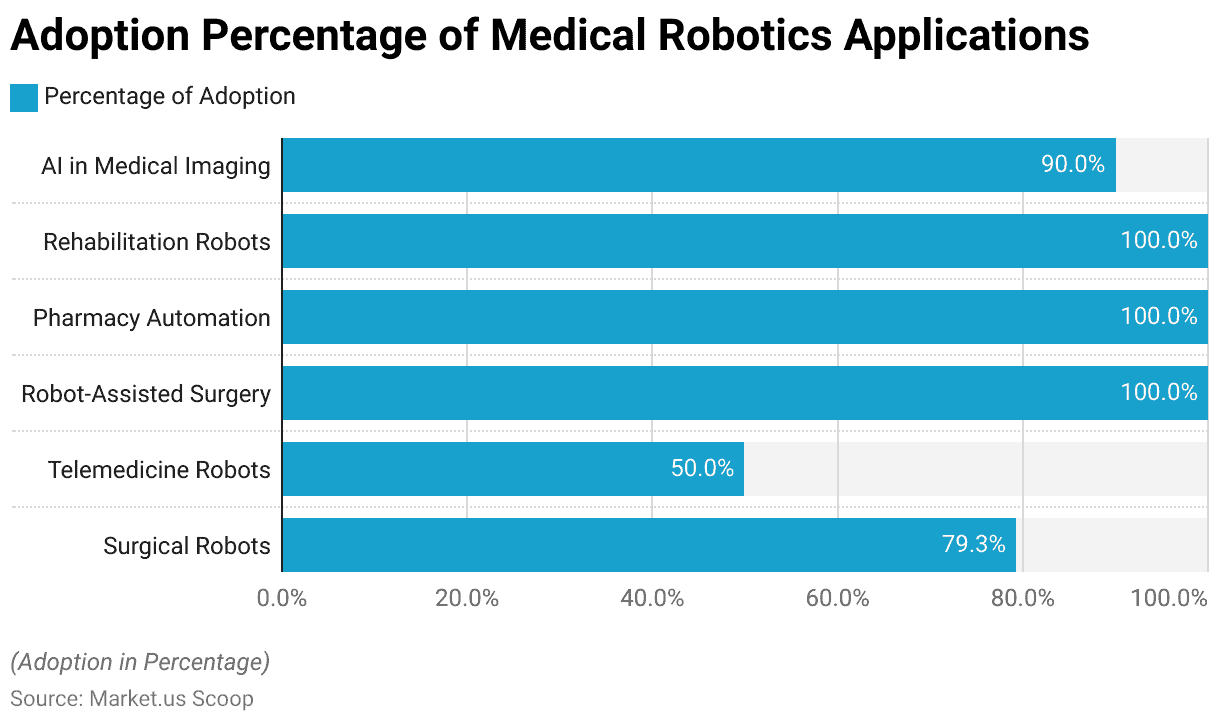
Robotics in Agriculture and Farming – Robot Statistics
- The global market for agricultural robots is projected to reach $12.8 billion by 2025, growing at a CAGR of 24.1% from 2020 to 2025.
- The use of agricultural drones is expected to increase by 40% annually, reaching 620,000 units deployed worldwide by 2025.
- Precision agriculture techniques, including robotic systems, could reduce chemical use by up to 90% and increase crop yields by 15% to 20%.
- The market for milking robots is estimated to grow at a CAGR of 12.2% from 2021 to 2026, driven by the need for labor-saving solutions in dairy farms.
- Global sales of agricultural autonomous tractors are predicted to exceed 60,000 units by 2026, with a compound annual growth rate of 24.8% from 2021 to 2026.
- Agricultural robots can reduce overall labor costs by 20% to 30% and address labor shortages in the agriculture industry.
- By 2030, it is estimated that robots and automation could replace up to 40% of labor in fruit and vegetable picking, harvesting, and packing.
- In 2021, the market for autonomous weeding robots was valued at $101 million, with a projected CAGR of 17.6% from 2021 to 2028.
(Source: Food and Agriculture Organization, IHS Markit, University of California, Davis)
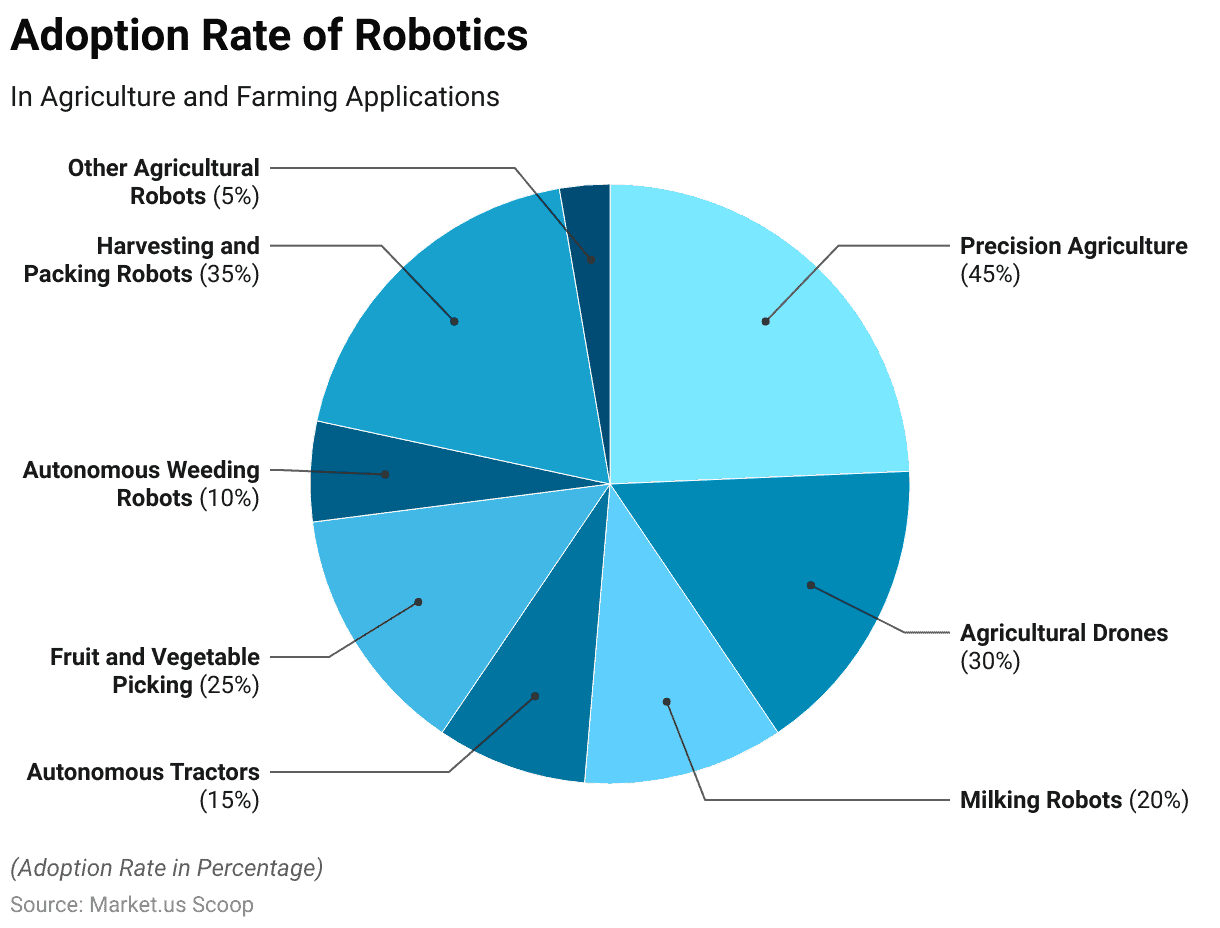
Robotics in Logistics and Warehousing – Robot Statistics
- The global logistics robotics market is projected to reach $5.7 billion by 2027, with a compound annual growth rate (CAGR) of 17.2% from 2020 to 2027.
- In 2021, the use of collaborative robots (cobots) in warehouses and logistics facilities increased by 38% globally.
- Warehouse order-picking robots can achieve a pick rate of up to 1,600 items per hour, significantly enhancing operational efficiency.
- The implementation of robotic automation in logistics can lead to cost savings of up to 20% and reduce order processing times by 65%.
- The number of deployed autonomous mobile robots (AMRs) in fulfillment centers grew by 86% in 2020, indicating a rapid adoption of robotic automation.
- Amazon, a major player in the logistics industry, has deployed over 200,000 mobile robots across its fulfillment centers worldwide.
- DHL, a global logistics company, reported a 25% increase in productivity after integrating robots into their warehouses.
- Approximately 80% of warehouses in the United States are expected to adopt robotics and automation by 2025.
(Source: Interact Analysis, Robotics Business Review, Supply Chain Dive, ABI Research, GeekWire, The Wall Street Journal, Supply Chain Dive)

Robotics in Construction and Infrastructure – Robot Statistics
- In 2020, the use of robotics in construction increased by 85%, signifying rapid adoption in the industry.
- Bricklaying robots can lay up to 1,000 bricks per hour, which is significantly faster than traditional human labor.
- Drones equipped with LiDAR technology can survey construction sites up to 10 times faster than traditional methods, improving efficiency and accuracy.
- Autonomous construction equipment, such as self-driving bulldozers and excavators, can increase productivity by up to 30% compared to manual operation.
- 3D printing robots are revolutionizing construction by enabling the creation of complex structures, reducing material waste by up to 60%.
- Robotics in infrastructure inspection can reduce inspection time by 90%, leading to quicker maintenance and lower operational costs.
- The use of exoskeletons in construction reduces worker fatigue and lowers the risk of on-site injuries, contributing to a 25% decrease in workplace accidents.
(Source: Tractica, Fastbrick Robotics, McKinsey & Company, The Robot Report, World Economic Forum, The B1M, Cintec)
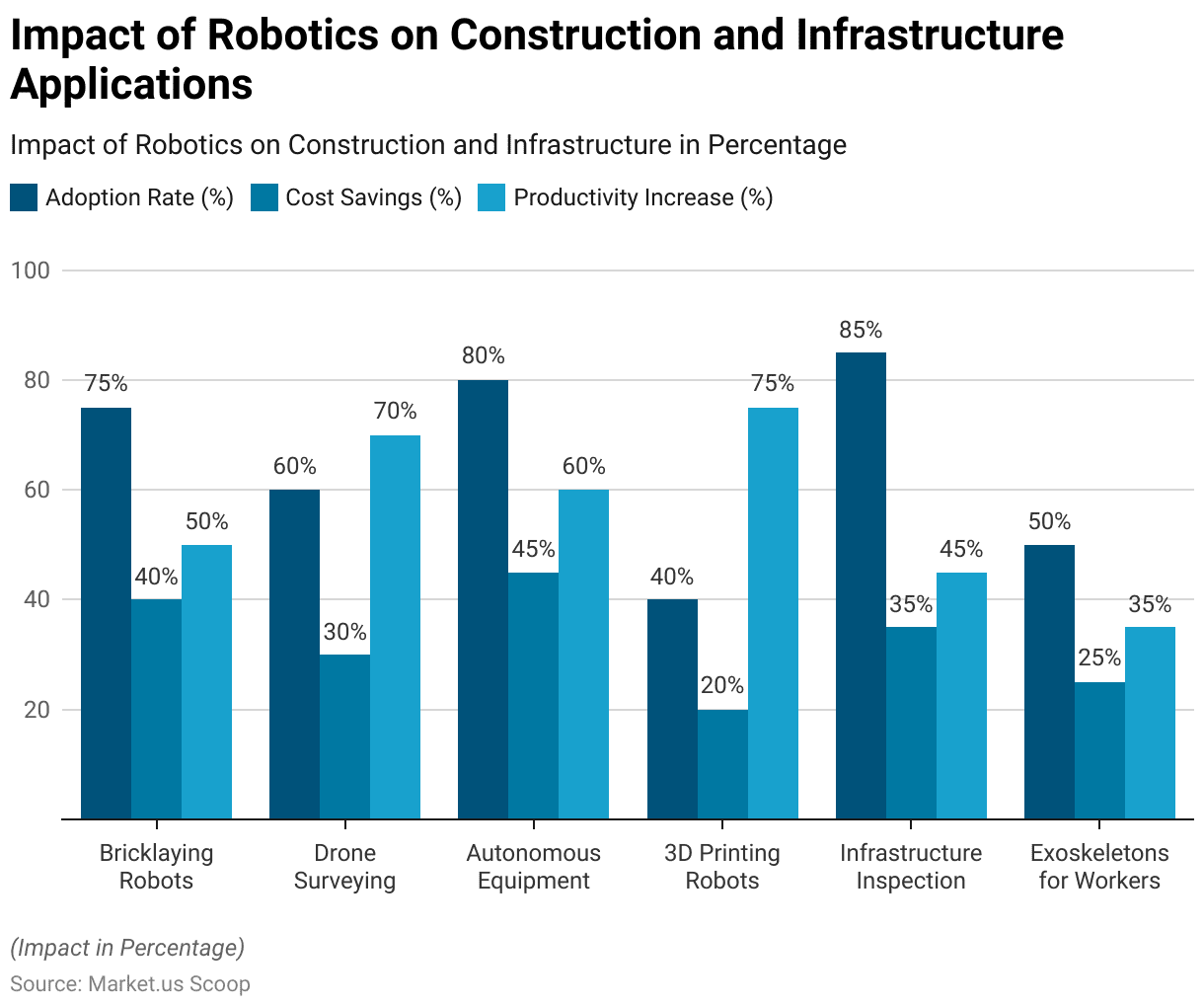
Robot Statistics – Robotics in Space Exploration and Research
- The Mars Rover missions, including Curiosity and Perseverance, have covered over 30 miles combined on the Martian surface.
- In 2020, there were over 2,800 active artificial satellites in Earth’s orbit. Many of which are used for space exploration and research purposes.
- The International Space Station (ISS) has been continuously occupied since November 2000. With astronauts from various countries conducting microgravity research.
- As of 2021, there have been more than 340 crewed spaceflights, with astronauts conducting scientific experiments and research in space.
- The Hubble Space Telescope has captured and transmitted over 1.4 million images, providing valuable data for astronomical research.
- The Voyager 1 spacecraft, launched in 1977, has entered interstellar space and is currently over 14 billion miles away from Earth.
(Source: Union of Concerned Scientists, Spacefacts.de)
Robot Workforce and Employment Impact
- Over 2 million industrial robots are estimated to be in operation worldwide by 2023.
- Automation is expected to displace around 20 million manufacturing jobs by 2030.
- For every robot deployed in the workplace, there is an average net loss of 1.6 human jobs.
- By 2025, the implementation of robotics is projected to lead to a productivity increase of up to 30% in many industries.
- The World Economic Forum estimates that automation could result in the loss of 85 million jobs globally across various industries by 2025.
- Despite job displacement fears, the adoption of robots is expected to create over 12 million new jobs by 2025.
(Source: International Federation of Robotics, Oxford Economics, National Bureau of Economic Research, McKinsey Global Institute, World Economic Forum)
Robot Safety and Ethical Considerations
- In 2020, there were approximately 37 robot-related accidents per 10,000 workers in the manufacturing industry.
- A survey conducted in 2021 found that 72% of respondents expressed concerns about the potential misuse of robotics and artificial intelligence.
- According to the European Union Agency for Cybersecurity (ENISA), the number of reported cybersecurity incidents involving robots and autonomous systems increased by 50% in 2022.
- As of 2021, over 50 countries have either developed or are in the process of formulating national strategies or guidelines for the ethical use of robots and AI technologies.
- The United Nations estimates that by 2030, the adoption of robotics and AI in the workplace could result in the displacement of approximately 20 million jobs worldwide.
- A study published in the Journal of Human-Robot Interaction found that 40% of participants experienced feelings of discomfort and anxiety while interacting with humanoid robots.
- According to a report by the Campaign to Stop Killer Robots, as of 2021. 30 countries had called for a preemptive ban on fully autonomous weapons systems.
- Research conducted by the Pew Research Center showed that 70% of respondents believe that robots and AI will most likely take over most of the jobs currently done by humans in the next 50 years.
- A survey by the Ada Lovelace Institute found that 63% of participants believe that robot developers should be legally liable for any harm caused by their machines.
- The World Economic Forum predicts that by 2025, more than half of all workplace tasks will be performed by machines. Increasing the importance of ethical considerations in robot deployment.
(Source: Pew Research Center, Ada Lovelace Institute, World Economic Forum)
Future Prospects of Robotics
- The global robotics market is projected to reach $275 billion by 2025. With a compound annual growth rate (CAGR) of over 17%.
- Artificial Intelligence (AI) integration in robotics is expected to create a $190 billion market opportunity by 2025.
- Collaborative robots (cobots) are expected to account for nearly 35% of all robot sales by 2027, fostering safer human-robot cooperation.
- By 2035, it is estimated that there will be approximately 2 million new jobs related to the robotics industry.
- Autonomous delivery robots are expected to handle over 25% of all last-mile deliveries in urban areas by 2030, enhancing logistics efficiency.
- Robotics and automation are estimated to save businesses $8 trillion in labor costs by 2030. Leading to increased productivity and economic growth.
(Source: Tractica, Interact Analysis, World Economic Forum, McKinsey & Company, Bank of America Merrill Lynch)
Recent Developments
Acquisitions and Mergers:
- Symbiotic merged with SVF Investment Corp. 3 in a deal valued at $4.8 billion, enhancing its capabilities in logistics robots.
- Ocado acquired 6 River Systems for $12.7 million, significantly lower than the $450 million paid by Shopify in 2019.
- DePuy Synthes acquired OrthoSpin, specializing in healthcare robotics.
New Product Launches:
- Apptronik launched the Apollo humanoid robot, aiming to commercialize humanoid robotics.
- Boston Dynamics introduced new capabilities for its Atlas robot, showcasing its dexterity and mobility at a simulated construction site.
- German Bionic released the Apogee+ powered exoskeleton, targeting the North American healthcare market.
Funding:
- Robotic Research secured $228 million in Series A funding, focusing on autonomous driving technology.
- The figure raised $70 million to support the development of its Figure 01 humanoid robot, achieving dynamic bipedal walking.
- Haomo attracted $157 million in Series A funding for its autonomous driving solutions.
Wrap Up
Robot Statistics – Robots have emerged as a transformative technology, reshaping industries and societies worldwide.
With their increasing sophistication, efficiency, and versatility, robots are becoming integral to various sectors, including manufacturing, healthcare, agriculture, and even personal assistance.
As they continue to evolve and integrate artificial intelligence, robots hold the potential to revolutionize daily life. Contributing to enhanced productivity, improved safety, and a new era of innovation.
While their proliferation also raises important ethical and societal questions, careful management and responsible deployment will undoubtedly shape a future where robots play a crucial role in addressing global challenges and improving human well-being.
FAQs
Robotics is a multidisciplinary field that deals with the design, construction, operation, and application of robots. Robots are machines or systems that can carry out tasks autonomously or semi-autonomously, often mimicking human actions or performing tasks in environments that are hazardous or impractical for humans.
Various programming languages are used in robotics, depending on the application and platform. Some popular choices include C/C++, Python, Java, ROS (Robot Operating System) for robotic systems, MATLAB for control and simulation, and Blockly or Scratch for teaching robotics to beginners and children.
While robots can automate repetitive and dangerous tasks, their impact on the job market is complex. Automation may displace certain jobs but can also create new job opportunities in the robotics industry and other sectors.
Discuss your needs with our analyst
Please share your requirements with more details so our analyst can check if they can solve your problem(s)



